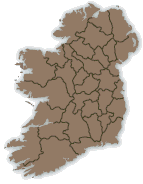Meascán Mhéabha - Maighréad Ní Dhomhnaill
Recording: [Download audio file]
[Download AIFF audio file (of processed ‘user’ version)]
[Download AIFF audio file (of archive version)]
Transcript
Bhí bean 'na cónaí uair amháin i mbaile ar a dtugtar Loch Beara agus bhí sí a fhad ar gcúl is nach rabh a fhios aici goidé an lá den tseachtain a bhí ann. Maidin Domhnaigh amháin thúsaigh sí a bhuaileadh maistreadh. Ghléas sí an chuinneog agus bhuail sí an bainne go dtáinig an t-im air. Nuair a bhí sin déanta aici fuair sí scála agus chuir sí uisce ann. Thug sí léithe síos go dtí an doras é agus d'fhág sí ar chathaoir é. Thóg sí an t-im isteach ann. Bhí binn os coinne an dorais amach ar an taobh eile den bhealach mhór agus nuair a bhí an t-im cóirithe aici ina mheascán dheas d'éirigh sé in airde amach as an scála agus ghreamaigh sé ar bharr na binne ar an taobh eile. Agus ón lá sin go dtí an lá inniu tá an meascán ansin. Agus fuair an bhinn an t-ainm 'Meascán Mhéabha'.
Translation
There once was a woman living in a place called Loughbarra and she was so far behind that she didn't know what day of the week it was. One Sunday morning she started churning. She prepared the churn and she churned the milk until the butter came. When she had done that she got a bowl and she put water into it. She brought it down to the door and she left it on a chair. She lifted the butter into it. There was a peak in front of the door on the other side of the road and when she had fixed the butter into a nice lump it rose up out of the bowl and it stuck onto the top of the peak beyond. And from that day until this the lump is there. And the peak got the name 'Meascán Mhéabha' ('Maeve's lump').
Commentary
This seems to be a local legend that serves an aetiological function, describing the origin of the name of a local topographical feature. The term meascán can be applied to the lumps of butter that form when churning, as described in the story. In topographical terms it likely refers to a rock, crag or cairn. Several of these are linked to Medb (Mod. Ir. Meadhbh/Méabh), a mythological goddess figure prominent in the lore relating to kingship and sovereignty, and a key character in the epic Táin bó Cuailnge. See Francis John Byrne, Irish kings and high-kings (Dublin, 2001), 51. A prominant example of one such Meascán Mhéabha can be found in the prehistoric stone feature on Knocknarea Mountain in county Sligo. Another example is Misgaun Meva near Rathcroghan, county Roscommon, a place well known in folklore and mythology for its links to Medb of Connacht. See John Waddell, 'Rathcroghan in Connacht', Emania 5 (1988), 5-18. The current example may be Meskanmave, a hilltop in Raymunterdoney parish, Kilmacrenan barony, in county Donegal.
Title in English: Maeve's churning
Digital version published by: Doegen Records Web Project, Royal Irish Academy
Description of the Recording:
Speaker:
Maighréad
Ní Dhomhnaill from Co.
Donegal
Person who made the recording:
Karl Tempel
Organizer and administrator of the recording scheme: The Royal Irish Academy
In collaboration with: Lautabteilung, Preußische Staatsbibliothek (now Lautarchiv,
Humboldt-Universität zu Berlin)
Recorded on 02-10-1931 at 11:00:00 in
Courthouse, Letterkenny. Recorded on 02-10-1931 at 11:00:00 in
Courthouse, Letterkenny.
Archive recording (ID LA_1250d2, from a shellac disk stored at the
Royal Irish Academy) is 00:49 minutes
long. Archive recording (ID LA_1250d2, from a shellac disk stored at the
Royal Irish Academy) is 00:49 minutes
long.
Second archive recording (ID LA_1250b2, from a shellac disc stored in
Belfast) is 00:48 minutes long. Second archive recording (ID LA_1250b2, from a shellac disc stored in
Belfast) is 00:48 minutes long.
User recording (ID LA_1250d2, from a shellac disk stored at the Royal
Irish Academy) is 00:47 minutes long. User recording (ID LA_1250d2, from a shellac disk stored at the Royal
Irish Academy) is 00:47 minutes long.





